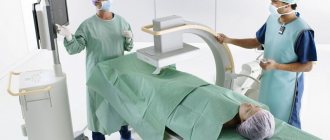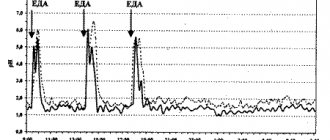In medical science there are terms that are understandable only to specialists.
One such concept is the cascading stomach. The name is beautiful, sometimes even romantic, but absolutely incomprehensible and frightening for a patient ignorant of medical terminology.
We propose to understand in detail what cascade deformation of the main digestive organ is and whether it is dangerous to health.
Not a diagnosis, but a condition
Cascade stomach is a term used by radiologists and doctors working in endoscopy rooms where EGD is performed. The stomach is a mobile organ, capable of functionally changing its shape depending on the patient’s posture, intake of food and drink, and other factors.
If a person is hungry, then during endoscopy or x-ray the doctor sees the organ in the form of a flat empty stocking, resembling a horn, with almost touching walls. When a contrast agent (barium) enters inside, the shape of the organ changes and takes on the appearance of a hook. These shape changes are clearly visible in photo 1.
Photo 1
If a person's stomach is filled with food or liquid, it is able to stretch, flatten, and its shape will resemble a giant sausage.
In the presence of a cascade inflection, the shape of the stomach is voluminous and convex in the area of the cardia, fundus and body, and narrowed in the area of the antrum and pylorus.
Photo 2 shows a cascading stomach, look at it carefully.
photo 2
The X-ray image clearly shows the bending of the organ around its own axis with the formation of two stages of the cascade - the upper wide and the lower narrow.
Such variability can be an innate structural feature or acquired.
According to radiologists, a hook-shaped stomach occurs in 60–80%, a horn-shaped stomach in 20%, and a stocking-like stomach in 5–9% of cases.
The cascade form accounts for up to 5% of survey results , which indicates a rare form.
Preparation and procedure
X-ray of the stomach is completely painless.
Any diagnosis of the body is aimed, first of all, at obtaining the most reliable results.
X-rays are no exception, so to improve the accuracy of the examination results, it is necessary to carry out some preparation before conducting it. In the case of an X-ray of the stomach, the preparatory measures are as follows:
- Firstly, it is important not to eat any food 8-10 hours before the examination. You can drink, preferably only water and still water.
- Secondly, 1-2 days before the x-ray, you should adhere to an extremely simple diet, the essence of which is to exclude from the diet all foods that increase gas formation (beans, cabbage, sour cream, etc.).
- Thirdly, although this is not necessary, it is still better to come for diagnosis with a cleansed stomach.
The procedure itself is carried out in two stages:
- First, a survey x-ray is performed, which allows you to obtain standard images of the human gastrointestinal tract.
- After this, the examined patient drinks a barium mixture or other contrast agent, then photographs of the stomach and intestines are taken from the necessary angles.
It is based on the results of two stages that the diagnostician and the doctor treating the patient will be able to obtain the most reliable information about the state of his gastrointestinal tract. Photographing internal organs is very simple:
- First of all, the patient removes all metal accessories and things.
- Next he takes off his outer clothing.
After this, it is placed in a special apparatus or stands in front of it for examination. The patient should not have any particular difficulties in performing x-rays, especially since if any questions arise, the person being examined will certainly be helped by a diagnostician or his assistant.
Congenital feature
If a child was born with a cascading stomach, parents may not be aware of it. But when feeding such children, certain difficulties may arise; the baby will spit up a lot after eating and gain weight poorly. In this case, the mother is recommended to choose anti-reflux formulas for feeding, which are thicker in consistency than regular ones.
Antireflux formula is not a substitute for feeding a baby, but is prescribed as a supplement to the traditional diet. Such babies need to be fed often, and in smaller portions, and after feeding, hold them in a “column” until air burps appear. Also, an excellent prevention of the formation of a cascading stomach is to place the baby on the tummy before each feeding.
With age, the cascade bend disappears, and the stomach takes on its normal shape.
Reasons for formation
An abnormally shaped stomach may be a congenital disorder. The cause of the anomaly is a failure at the stage of development of the organ from the intestinal tube at 4–10 weeks of embryonic development. During this period, the impact on the mother’s body of unfavorable factors such as: alcohol, medications, drugs, infectious agents (mycoplasma, herpes, rubella) disrupt this process, which leads to the development of abnormalities.
In adults, a cascaded stomach is most often a consequence of the formation of scar tissue in diseases of the digestive tract such as chronic peptic ulcers, long-term perigastritis and periduodenitis. The chronic inflammatory process that develops in these diseases leads to intensive formation of adhesions and connective tissue, which seem to tighten the organ, changing its shape.
A bend in the stomach can also be a functional disorder. The reason for this is compression of the organ by loops of the large intestine, excessive intestinal mobility, flatulence, and weakness of the abdominal wall muscles. In this case, the bend disappears after changing the position of the body. If the intestine, which compresses the stomach, is fixed in the abdominal cavity by adhesions, the inflection remains constant.
Acquired conditions: causes and symptoms
The cascade bend itself is not a disease and may not cause any concern to the patient. However, there are a number of reasons that play a significant role in changing the shape of the stomach, these are:
- Gastritis.
- Stomach ulcer.
- Duodenitis.
- Cholecystitis.
- Colitis.
Against the background of the listed pathologies, cicatricial changes in the stomach tissues form, forming an inflection. Most often this is observed after the ulcer has healed. With duodenitis and cholecystitis, duodenal reflux may be present, leading to a change in shape. Any disruption of the digestive process has a negative effect on the stomach.
Experts describe other reasons for the formation of the cascade, these are:
- Increased gas formation in the intestines, when a loop of intestine seems to “capture” the stomach.
- Oncological tumors can deform an organ.
- Stress and strong emotional tension are also indicated by some authors as provoking factors, but this statement is controversial.
If the cascade defect is combined with inflammation of the mucous membrane, the symptoms of the disease will prevail. The patient in these cases complains of nausea, heartburn, and a feeling of fullness in the stomach . Vomiting occurs periodically, especially when overeating.
In healthy patients, symptoms may also appear, but they are easy to eliminate without drug treatment.
Symptoms
Congenital deformation of the stomach manifests itself in a child in the first months of life. Main symptoms:
- Constant regurgitation after eating. One of the most common symptoms of this anomaly. The result of the presence of constriction and impaired tone of the muscle layer.
- Frequent vomiting, in severe cases, a fountain. The presence of a constriction in the stomach leads to the fact that food initially enters a small area of the organ. It fills quickly with even a small amount of milk or formula. In young children, an overfilled stomach leads to severe vomiting.
- The child behaves restlessly, often cries, and wiggles his legs. Reflection of abdominal discomfort experienced by a newborn.
- Poor weight gain. Frequent vomiting and regurgitation reduce the amount of nutrients entering the child's body.
Regurgitation and vomiting caused by a bend in the stomach are very dangerous for newborns, as they can lead to the reflux of the contents of the digestive tract into the respiratory tract, leading to asphyxia and pneumonia.
In adults, the main manifestations of inflexion of the stomach are:
- Heaviness, feeling of fullness in the epigastric region (epistochum). After eating a large amount of food, the patient experiences severe discomfort in the stomach.
- Nausea. Manifestation of impaired motility of the digestive tract.
- Vomiting after eating. The presence of a constriction leads to the fact that food enters only a narrow limited area of the organ, which quickly becomes overfilled even with a small amount of food.
- Loss of body weight. It develops in severe cases, most often in the presence of concomitant diseases of the digestive tract (gastritis, duodenitis, ulcers). Associated with impaired digestion and poor absorption of nutrients.
In addition, patients also experience symptoms characteristic of the underlying disease (gastritis, duodenitis, ulcers): pain, heartburn, dyspepsia, digestion and absorption disorders.
Self help
If the cascade form of the organ is not associated with other digestive pathologies, you can get rid of unpleasant symptoms using the following measures:
- perform several slow bends to the sides;
- perform several slow bends forward;
- lie straight on your right side and maintain this position until the discomfort disappears.
Patients are not recommended to wear tight belts or shapewear. Physical activity, carrying heavy loads, strength sports training and stress on the abdominal muscles can lead to worsening of the condition.
The diet should also be thought out. You should eat small meals and not consume harmful foods - smoked meats, fatty meats, marinades, alcohol . All of them cause increased secretion, which, if cascaded, will provoke reflux and deterioration of well-being.
A useful video will help you learn simple exercises to improve stomach function:
Pyloric insufficiency
The pylorus of the stomach is the site of its transition to the duodenum. Another name for the organ is sphincter (pylorus, valve). The main function of the pylorus is to control the passage of partially digested food from the stomach into the small intestine. Normally, the muscle is constantly in a closed state, from time to time passing small portions of semi-digested food further along the digestive tract. With insufficiency of the pylorus of the stomach, this process is disrupted, so the pathology requires complex treatment.
When are medications needed?
The condition cannot be treated with medications. They are used only in cases where the cascade defect is combined with other pathologies - gastritis, colitis, ulcers and other digestive disorders.
Medicines are prescribed by a doctor, and they should be taken strictly in accordance with the recommendations. We want to warn patients who like to “treat themselves” on their own. Did you know that harmless Omeprazole, when taken uncontrolled, increases the risk of bone fractures, and all antiemetic drugs without exception cause serious constipation? Therefore, take medications only when they are prescribed for you, and never again.
What is pyloric insufficiency?
This is a disease in which the muscle ring of the pylorus does not close completely, resulting in a disruption of the digestive process. Pathology is usually diagnosed:
- in older people due to weakening muscle tone throughout the body;
- in pregnant women against the background of hormonal changes;
- as a congenital pathology requiring surgical intervention.
Pyloric insufficiency may occur due to:
- pathologies of the nervous system;
- neoplasms in the digestive organs;
- gastritis, duodenitis and other inflammatory diseases;
- frequent overeating, improper diet;
- hormonal changes.
A healthy pylorus protects the sensitive intestinal mucosa from the effects of gastric juice. In addition, the food has time to break down and form chyme.
Diet for pyloric insufficiency
First of all, doctors recommend switching to fractional meals. You need to eat food often (5-6 times a day), but in small portions. It is advisable to do this on schedule at the same time.
After eating, it is important to be in an upright position for at least two hours. The best option is to get up from the table slightly hungry; overeating is not allowed to avoid attacks.
| Can | It is forbidden |
| Low-fat soups and liquid porridges. | Fatty, fried, spicy and smoked foods. |
| Soft-boiled eggs, steam omelet. | Fried eggs. |
| Milk, cottage cheese, natural yogurt, low-fat cream. | Fatty fermented milk products. |
| Kissel, non-acidic fruit drink, still water. | Tea, coffee, carbonated drinks. |
| Sweets and bread are allowed in limited quantities. | Chocolate. |
| Fruits and vegetables. | Tomatoes in any form. |
Pyloric insufficiency is one of those pathologies against which other diseases of the gastrointestinal tract rapidly begin to develop. In order to prevent this, it is important to undergo examination and treatment on time. With diet, regular exercise and medication, the disease can be controlled and its symptoms reduced.








